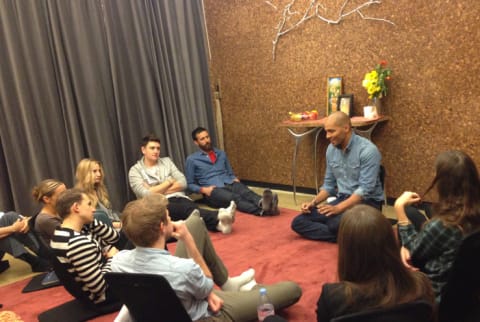Advertisement


Are you determined to teach yourself how to meditate and start a new daily routine? Good! There are countless benefits to a daily meditation practice, though it might be challenging to get started. If you're new to meditation, you’ll want to make sure you follow this cheat sheet of insider tips, strategies, and best practices, so you get the most out of your efforts.
There’s no rule that says meditation is only effective if done on the floor.
1. Make friends with your mind.
Monkey mind syndrome (when you're trying to concentrate but your mind is jumping around) is incredibly common, as you will learn when you start meditating. The way to overcome it might surprise you.
Instead of trying to control the thinking mind, go the other way with it and embrace it. Expect there to be thoughts in meditation, and lots of them. Practice being friendly with all of the thoughts, especially the negative ones. Try not to push them away or get caught up in them; just observe them and bring yourself back to your breathing. The more you practice this, the easier it gets and the sooner you discover that the key to silencing the mind is being completely indifferent to all of your thoughts.
2. You don't need to be a frozen sculpture.
Sitting still with your back relatively straight is fine. But if you have to cough, sneeze, scratch, shift, or clear your throat, don’t go into convulsions while trying to will it away. Instead, stay natural and allow yourself to take care of the minor disturbances and distractions. That way you'll remain comfortable enough to keep going.
3. Practice sitting with your palms up instead of fingers together.
The big question is what to do with your hands. We see in pictures people sitting with their fingers together. Instead of bringing your thumb and index finger together, try just resting your hands on your lap, with palms facing up. This still keeps your energy open and alert without having to remember to keep your fingertips touching.
4. Sit in a position you feel comfortable in.
There are many meditation stools and cushions on the market. I recommend opting for the more comfortable options. But before you invest in a stool, try just stacking some pillows and building up a routine. Or, if sitting on the floor is unbearable, give yourself permission to sit in a chair or even on a couch. There’s no rule that says meditation is only effective if done on the floor.
5. DON’T USE AN ALARM!
You are probably wondering why this point is in all caps, thinking it is unnecessarily alarming. That’s the idea — being alarmed out of meditation is just as unnecessary. As your mind is settling in the last half of your meditation, and your alarm goes off, you’re going to jump out of your skin. And it’s not going to leave you feeling good. Instead, keep a digital or analog clock nearby and just allow yourself to glance at it whenever you’re curious about the time.
6. Go for quantity over quality.
No, that isn't a typo. When it comes to meditation, the saying “quality over quantity” doesn’t apply. Instead, it’s the opposite. You should practice being completely unconcerned about the quality of your meditations and instead strive for quantity. In other words, be as consistent as possible. Meditate daily, without fail if you can. What you’ll discover is that the quality of your inner experiences will improve solely from the quantity, or the number of times you sit.
7. Keep a log.
Meditation will become a habit the more often you do it. As a psychological advantage, putting an “x” in your calendar after fulfilling your daily commitment will motivate you to keep going, especially on those days when the last thing you want to do is sit down to meditate. Keep your goals small and achievable. Start with a goal of meditating every day for at least 10 minutes for seven days in a row. And as you meet your objective, increase your meditation time from there.

Light Watkins is a Santa Monica–based Vedic Meditation teacher, mindbodygreen class instructor, TEDx speaker, and author of Bliss More, How to Succeed in Meditation Without Really Trying. He grew up in Montgomery, Alabama, and graduated from Howard University with a bachelor's in communications. Watkins recognized his passion for teaching meditation after meeting his Guru in 2002. Following years of daily meditation, Vedic studies, and apprenticeship, he traveled to India to be trained in the ancient ways of teaching meditation. His students have used meditation to treat symptoms of PTSD, hypertension, sleep deprivation, anxiety, depression, and cancer.
More from the author:
A Meditation Expert's 14-Day Guide
Check out 14 Days To A Daily Meditation Practice - Yes, It's That Easy!
More from the author:
A Meditation Expert's 14-Day Guide
Check out 14 Days To A Daily Meditation Practice - Yes, It's That Easy!

Light Watkins is a Santa Monica–based Vedic Meditation teacher, mindbodygreen class instructor, TEDx speaker, and author of Bliss More, How to Succeed in Meditation Without Really Trying. He grew up in Montgomery, Alabama, and graduated from Howard University with a bachelor's in communications. Watkins recognized his passion for teaching meditation after meeting his Guru in 2002. Following years of daily meditation, Vedic studies, and apprenticeship, he traveled to India to be trained in the ancient ways of teaching meditation. His students have used meditation to treat symptoms of PTSD, hypertension, sleep deprivation, anxiety, depression, and cancer.
Watch Next
Enjoy some of our favorite clips from classes
Enjoy some of our favorite clips from classes
What Is Meditation?
Mindfulness/Spirituality | Light Watkins
Box Breathing
Mindfulness/Spirituality | Gwen Dittmar
What Breathwork Can Address
Mindfulness/Spirituality | Gwen Dittmar
The 8 Limbs of Yoga - What is Asana?
Yoga | Caley Alyssa
Two Standing Postures to Open Up Tight Hips
Yoga | Caley Alyssa
How Plants Can Optimize Athletic Performance
Nutrition | Rich Roll
What to Eat Before a Workout
Nutrition | Rich Roll
How Ayurveda Helps Us Navigate Modern Life
Nutrition | Sahara Rose
Messages About Love & Relationships
Love & Relationships | Esther Perel
Love Languages
Love & Relationships | Esther Perel

















